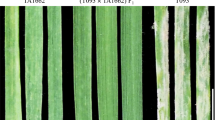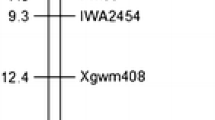Abstract
The powdery mildew resistance from Avena macrostachya was successfully introgressed into hexaploid oat (A. sativa). Genetic analysis of F1, F2, F3 and BC1 populations from two powdery-mildew resistant introgression lines revealed that the resistance is controlled by a dominant gene, tentatively designated Eg-5. Molecular marker analysis was conducted using bulked-segregant analysis in two segregating F3 populations. One codominant simple sequence repeats (SSR) marker AM102 and four AFLP-derived PCR-based markers were successfully developed. The SSR marker AM102 and the STS marker ASE41M56 were linked to the gene Eg-5, with genetic distances of 2 and 0.4 cM, respectively, in both mapping populations. Three STS markers (ASE45M56, ASE41M61, ASE36M55) co-segregated with Eg-5 in one population while two (ASE45M56, ASE36M55) of them linked to Eg-5 with a genetic distance of 1 cM in another population. The gene was further mapped to be in a region corresponding to linkage group 22_44+18 in the Kanota × Ogle (KO) hexaploid oat map by comparative mapping. To our knowledge, this is the first report of mapping powdery-mildew resistance in hexaploid oat. The new resistance source of A. macrostachya, together with the tightly linked markers identified here, could be beneficial in oat breeding programmes.



Similar content being viewed by others
References
Aung T, Thomas H, Jones IT (1977) The transfer of the gene for mildew resistance from Avena barbata (4x) into the cultivated oat A. sativa by an induced translocation. Euphytica 26:623–632
Baum BR, Rajhathy T (1976) A study of Avena macrostachya. Can J Bot 54:2434–2439
Brugmans B, van der Hulst RGM, Visser RGF, Lindhout P, van Eck HJ (2003) A new and versatile method for the successful conversion of AFLP markers into simple single locus markers. Nucleic Acids Res 31:e55
Dussle CM, Quint M, Xu ML, Melchinger AE, Lübberstedt T (2002) Conversion of AFLP fragments tightly linked to SCMV resistance genes Scmv1 and Scmv2 into simple PCR-based markers. Theor Appl Genet 105:1190–1195
Gebhardt C, Ritter E, Barone A, Debener T, Walkemeier B, Schachtschabel U, Kaufmann H, Thompson RD, Bonierbale MW, Ganal WM, Tanksley SD, Salamini F (1991) RFLP maps of potato and their alignment with the homoeologous tomato genome. Theor Appl Genet 83:49–57
Hayes JD, Jones IT (1966) Variation in the pathogenicity of Erysiphe graminis D.C. f.sp. avenae, and its relation to the developement of mildew-resistant oat cultivars. Euphytica 15:80–86
Herrmann M, Roderick HW (1996) Characterisation of new oat germplasm for resistance to powdery mildew. Euphytica 89:405–410
Holland JB, Helland SJ, Sharopova N, Rhyne DC (2001) Polymorphism of PCR-based markers targeting exons, introns, promoter regions, and SSRs in maize and introns and repeat sequences in oat. Genome 44:1065–1076
Holland JB, Portyanko VA, Hoffman DL, Lee M (2002) Genomic regions controlling vernalization and photoperiod responses in oat. Theor Appl Genet 105:113–126
Hoppe HD, Kummer M (1991) New productive hexaploid derivatives after introgression from A. pilosa features. Vortr Pflanzenzüchtg 20:56–61
Hoppe HD, Pohler W (1988) Successful hybridisation between Avena prostrata and A. macrostachya. Cereal Res Commun 16:231–235
Hsam SLK, Peters N, Paderina EV, Felsenstein F, Oppitz K, Zeller FJ (1997) Genetic studies of powdery-mildew resistance in common oat (Avena sativa L.) I. Cultivars and breeding lines grown in Western Europe and North America. Euphytica 96:421–427
Hsam SLK, Zeller FJ (1998) Chromosomal location of genes for resistance to powdery mildew in cultivated oat (Avena sativa L.). 1. Gene Eg-3 in the cultivar ‘Mostyn’. Plant Breed 117:177–178
Irigoyen ML, Loarce Y, Fominaya A, Ferrer E (2004) Isolation and mapping of resistance gene analogs from the Avena strigosa genome. Theor Appl Genet 109:713–724
Jones IT (1983) Transgressive segregation for enhanced level of adult plant resistance to mildew in the oat cross Mostyn × Maldwyn. Euphytica 32:499–503
Leggett JM (1985) Interspecific hybrids involving the perennial oat species Avena macrostachya. Can J Genet Cytol 27:29–32
Li CD, Rossnagel BG, Scoles GJ (2000) The development of oat microsatellite markers and their use in identifying relationships among Avena species and oat cultivars. Theor Appl Genet 101:1259–1268
Michelmore RW, Paran I, Kesseli RV (1991) Identification of markers linked to disease-resistance genes by bulked segregant analysis: a rapid method to detect markers in specific genomic regions by using segregating populations. Proc Natl Acad Sci U S A 88:9828–9832
Negi MS, Devic M, Delseny M, Lakshmikumaran M (2000) Identification of AFLP fragments linked to seed coat colour in Brassica juncea and conversion to a SCAR marker for rapid selection. Theor Appl Genet 101:146–152
Pal N, Sandhu JS, Domier LL, Kolb FL (2002) Development and characterization of microsatellite and RFLP-derived PCR markers in oat. Crop Sci 42:912–918
Pohler W, Hoppe HD (1991) Avena macrostachya—a potential gene source for oat breeding. Vortr Pflanzenzüchtg 20:66–71
Roderick HW, Jones ERL, Sebesta J (2000) Resistance to oat powdery mildew in Britain and Europe: a review. Ann Appl Biol 136:85–91
Ruge B, Linz A, Pickering R, Proeseler G, Greif P, Wehling P (2003) Mapping of Rym14Hb, a gene introgressed from Hordeum bulbosum and conferring resistance to BaMMV and BaYMV in barley. Theor Appl Genet 107:965–971
Santos A, Livingston DP, Murphy JP (2002) Agronomic, cytological and RAPD evaluations of Avena sativa × A. macrostachya populations. In: Proceedings of Eastern wheat workers and southern small grain workers
Sardesai N, Kumar A, Rajyashri R, Nair S, Mohan M (2002) Identification and mapping of an AFLP marker linked to Gm7, a gall midge resistance gene and its conversion to a SCAR marker for its utility in marker aided selection in rice. Theor Appl Genet 105:691–698
Shirasawa K, Kishitani S, Nishio T (2004) Conversion of AFLP markers to sequence-specific markers for closely related lines in rice by use of the rice genome sequence. Mol Breed 14:283–292
Simons MD, Martens JW, McKenzie RIH, Nishiyama I, Sadanaga K, Sebesta J, Thomas H (1978) Oats: a standardized system of nomenclature for genes and chromosomes and catalog of genes governing characters. U.S. Department of Agriculture, Agriculture Handbook 509, Washington DC
Thomas H, Powell W, Aung T (1980) Interfering with regular meiotic behaviour in Avena sativa as a method of incorporating the gene for mildew resistance from A. barbata. Euphytica 29:635–640
Van Ooijen JW, Voorrips RE (2001) JoinMap version 3.0, software for the calculation of genetic linkage maps. Plant Research International, Wageningen, http://www.kyazma.nl/index.php/mc.JoinMap
Vos P, Hogers R, Bleeker M, Reijans M, van der Lee T, Hornes M, Frijters A, Pot J, Peleman J, Kupier M, Zabeau M (1995) AFLP: a new technique for DNA fingerprinting. Nucleic Acids Res 23:4407–4414
Weibull J (1986) Screening for resistance against Rhopalosiphum padi (L.). I. Avena species and breeding lines. Euphytica 35:993–999
Wight CP, Tinker NA, Kianian SF, Sorrells ME, O’Donoughue LS, Hoffman DL, Groh S, Scoles GJ, Li CD, Webster FH, Phillips RL, Rines HW, Livingston SM, Armstrong KC, Fedak G, Molnar SJ (2003) A molecular marker map in ‘Kanota’ × ‘Ogle’ hexaploid oat (Avena spp.) enhanced by additional markers and a robust framework. Genome 48:28–47
Wight CP, O’Donoughue LS, Chong J, Tinker NA, Molnar SJ (2004) Discovery, localization, and sequence characterization of molecular markers for the crown rust resistance genes Pc38, Pc39, and Pc48 in cultivated oat (Avena sativa L.). Mol Breed 14:349–361
Zhu S, Kolb FL, Kaeppler HF (2003) Molecular mapping of genomic regions underlying barley yellow dwarf tolerance in cultivated oat (Avena sativa L.). Theor Appl Genet 106:1300–1306
Acknowledgements
We thank Dr. P. Wehling, Dr. B. Hackauf and Dr. B. Ruge for their valuable suggestions and helpful advice.
Author information
Authors and Affiliations
Corresponding author
Additional information
Communicated by B. Friebe
Rights and permissions
About this article
Cite this article
Yu, J., Herrmann, M. Inheritance and mapping of a powdery mildew resistance gene introgressed from Avena macrostachya in cultivated oat. Theor Appl Genet 113, 429–437 (2006). https://doi.org/10.1007/s00122-006-0308-0
Received:
Accepted:
Published:
Issue Date:
DOI: https://doi.org/10.1007/s00122-006-0308-0




